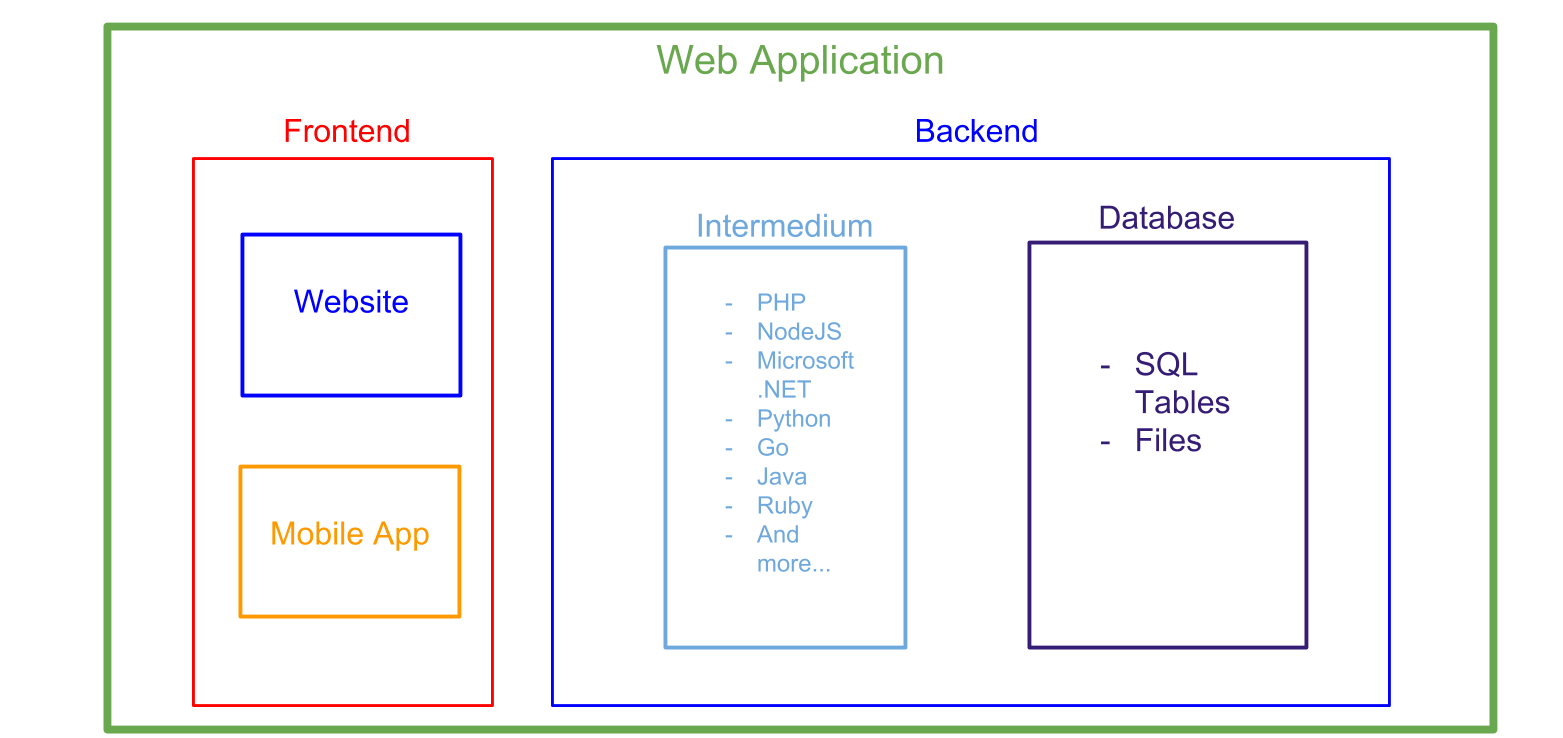Web application structure from a web developer's point of view
What is a web application?
Unless you're already an experienced programmer, this definition might not make much sense to you at first. That's fine, as this entire lesson is dedicated to explaining it:
A web application or web app is a client–server computer program in which the client (including the user interface and client-side logic) runs in a web browser.
But what does that mean?

As shown in Figure 1.1, a web app is composed of two main parts: a frontend and a backend. The frontend is a set of computer programs that run on the user's computer (the client computer), while the backend is a different set of computer programs that run on a more powerful server computer.
So this definition is really just saying that a web application is a big set of computer programs, separated into a frontend and a backend, that is viewed in your web browser (and I extend this definition to include mobile apps).
The Frontend
Simply put, the frontend is everything you see when you look at a website, or open a mobile app. For example, go to Google.com. Take a look around. You might see some text, some images, and a big search box in the middle. All these components are drawn on your screen by the frontend code.
The stuff you see on the webpage is called the user interface, or UI.
Frontend languages
The Frontend can be either a website or a mobile app (or both), as shown in Figure 1.1. The main three languages for building a website are HTML, CSS, and JavaScript (JS). HTML defines content, CSS defines how that content should look, and JavaScript adds interactivity to the page.
A mobile app frontend has more options. Here are some of them: Swift, Java, Kotlin, JavaScript, and, more recently, Dart.
The Backend
The backend is a bit harder to conceptualize than the frontend. Go back to Google. Look around again. As I said before, all this is drawn by the frontend code. But the frontend code isn't able to provide all of that information on its own. When you visited that site, your computer asked the backend server for the frontend code. The frontend code then asked the server for some information, such as whether the user is logged in, and where their profile picture is located. These are things that only the backend knows. In this way, the frontend and backend work together to present all the information the user needs.
Parts of the backend
The backend can be further divided into two primary parts: the database and the intermedium. The database holds all your users' information, while the intermedium asks the database for information the frontend needs.
Database Languages
The database is more of a storage area, so it doesn't have a lot of code involved, although if you are using PostgreSQL, MySQL, or other SQL database systems, you will be using SQL to query that database.
Intermedium languages
The intermedium has the most language options of any other part of your web application. Here are some of the most popular: PHP, Python, Ruby, Perl, C, C++, JavaScript (via NodeJS), and many more.
Why do we have an intermedium?
The frontend languages are not allowed to access the database. To see why, let's imagine what might happen if they could. Any user can, in a sense, edit any and all of your frontend code. Mind, they can't edit the actual files on your server, but they can edit the version that is being run on the client computer. If the frontend languages were able to access the database directly, a user could easily obtain sensitive information such as usernames, passwords, or credit card numbers.
Since we can't have that happening, the frontend languages cannot access the database, and instead we have the intermedium. The intermedium is allowed to access the database, but it cannot be tampered with by the users. Instead, the frontend languages can "ask" the intermedium to get certain data from the database, and the intermedium will make sure that user is allowed to access that information. If they are, it will get from the database, then pass it back to the frontend.
In other words, having an intermedium is like placing a "wall" between the frontend and the database, with a guard at the door making sure nobody gets through who isn't allowed to.
You'll begin to notice as you get deeper into the backend that security becomes a very important factor. You're always going to have to remember that there are people who will want to break into your application, and even little mistakes can result in a big problem.
Review
In summary, a web application is simply a set of computer programs, composed of a frontend and a backend, that work together to give the user a certain service. The frontend generates everything you see (UI), and the backend helps the frontend get the right information. For security purposes, the backend is split into an intermedium and a database.
I hope this helped someone who is just starting on their web development journey!